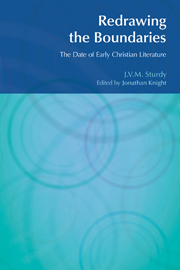Book contents
- Frontmatter
- Contents
- Preface
- Abbreviations
- 1 The Problem Posed
- 2 1 Clement
- 3 The Letters of Ignatius
- 4 Polycarp
- 5 Early Christian Literature: Some Parameters of Date
- 6 The Relationship of the Synoptic Gospels
- 7 Mark
- 8 Luke
- 9 Matthew
- 10 Acts
- 11 The Pauline Corpus: Its Growth and Development
- 12 The Catholic Epistles
- 13 Johannine Literature
- 14 Summary and Conclusions
- Appendix
- Notes
- Bibliography
- Index of Names
- Index of References
8 - Luke
- Frontmatter
- Contents
- Preface
- Abbreviations
- 1 The Problem Posed
- 2 1 Clement
- 3 The Letters of Ignatius
- 4 Polycarp
- 5 Early Christian Literature: Some Parameters of Date
- 6 The Relationship of the Synoptic Gospels
- 7 Mark
- 8 Luke
- 9 Matthew
- 10 Acts
- 11 The Pauline Corpus: Its Growth and Development
- 12 The Catholic Epistles
- 13 Johannine Literature
- 14 Summary and Conclusions
- Appendix
- Notes
- Bibliography
- Index of Names
- Index of References
Summary
Luke's Gospel is, according to many commentators, the most attractive of the Synoptics. Luke shows an obvious interest in the Gentiles (it is to this extent much less “exclusive” than Matthew), and is concerned also with women and underdogs. This makes the Gospel for the most part a pleasure to read.
Luke is the second Gospel in the chronological sequence. In terms of its relations with other New Testament literature, Luke knows Mark and is itself known by John and by Acts in its present form. I think that Luke is known also by Matthew, for which it serves as the source. A major feature of my research in this book is to disconnect Luke from Acts in terms of their authorship.
Luke was certainly written after 70 CE. This point is acknowledged even by conservative commentators. Crucial evidence for this view is provided by 21:20: “But when you see Jerusalem encircled by armies, then you may be sure that her devastation is near.” This is such a clear reference to 70 CE that it is impossible to set the Gospel before that date. Luke's use of Mark can hardly be denied, and I do not think that Mark was written until c.80–85 CE.
In terms of a terminus ante quem, Luke is said to have been used by Basileides at Alexandria (c.135) as the basis of his Exegetica. Marcion used Luke in Rome c.140 as the primary form of Gospel. Clearly, Luke must have been written by this time.
- Type
- Chapter
- Information
- Redrawing the BoundariesThe Date of Early Christian Literature, pp. 42 - 44Publisher: Acumen PublishingPrint publication year: 2008



